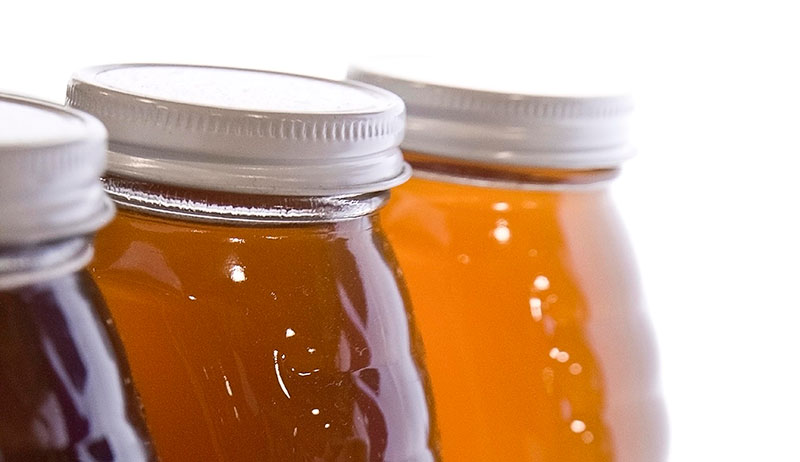
Before cane sugar was inserted into every packaged good–and before the synthesizing of corn into high-fructose corn syrup–pure, raw honey was one of the sweetest foods a human could enjoy. When it wasn’t feeding colonies of bees over the winter, it worked as a preservation agent in canned goods and was fermented into mead. It was loved and coveted by humans around the globe and still is.
Here are eight amazing facts about the nectar of the gods and goddesses.
1. Honey Is Liquid Sugar
The breakdown of its components looks something like this:
- Nearly 80 percent of honey is some form of sugar, roughly 40 percent fructose (levulose); 30 percent glucose (dextrose); 10 percent maltose; and give or take a small variety of other sugars. This composition actually makes honey sweeter than table sugar.
- At least 18 percent of honey is water. The bees fan it to achieve this exact percentage.
- The remaining 2 percent or less of honey is composed of a variety of trace minerals, pollen grains, flower enzymes and natural chemicals (both floral and honeybee).
2. Honey Ferments When the Moisture Level Reaches 20 Percent
When flower nectar is stored in the hive’s comb, house bees that are assigned to the task of making honey use their wings to fan—and thus dry out—the raw nectar. They add a variety of enzymes to the raw nectar to turn it into honey; however, getting the moisture content just right is critical to avoid fermentation (and not the good kind).
This is important to note as a beekeeper, as well. In order to harvest completed honey—that is, nectar that has been fully transformed into honey—the beekeeper must wait until the honey comb cells are capped. Capping is the signal that the honey is complete, stored and awaiting winter needs. Only then may a beekeeper safely harvest any surplus for themselves.
3. Many Honey Types Are Prone to Granulation
This process occurs when honey has been stored for a very long time, either by the beekeeper or the bees themselves. Some varieties of honey are more prone to granulation than others, simply due to the fact that some honeys contain more sugar. The glucose sugars in the honey form the crystals that lead to granulation. The sweet spot of granulation tends to be 55 degrees F; cooler than that, and the honey tends to remain preserved. Warmer than that, and honey usually remains in its liquid form. Most granulated honey can be returned to its liquid form by slowly and gently heating it over a very low heat.
4. Honey Is Smooth & Liquid When Raw
If you were to cut a natural honeycomb, straight from the hive, raw honey would drip and ooze right out. Be aware of specialty honeys sold in stores that claim to be raw when they are in fact altered. Creamed honey is one example: this process uses low temperatures to slow the crystallization process of raw honey, and creates a silky, but firm, whipped-like consistency. While fundamentally changed, creamed honey certainly has its place in the pantry, particularly if home-made, the old fashioned way, so as to preserve the honey’s nutrients and flavor integrity, and many love it for its easy use in the kitchen. Firmer texture means less mess, and it can be easily flavored.
5. Don’t Feed Honey to Infants Less Than 1 Year Old
Honey contains Clostridium botulinum (botulism) spores that can colonize the unsealed gut and young immune system, resulting in infant botulism. Very wee ones will have to wait a bit until they can enjoy the honeybee’s sweetness.
6. Honey Originally Came From Feral Hives
Before the Rev. Lorenzo Lorraine Langstroth developed the hive system and structure that is the common domestic bee home we know today, honeycomb was cut directly from feral hives, and honey was extracted by crushing the valuable comb. Today, many beekeepers tending to bees housed in Langstroth hives have the benefit of being able to extract the honey using centrifugal force from extractors suited to Langstroth frames. This preserves the comb, which is more valuable, pound for pound, than honey, and allows the bees to reuse it and fill it with more honey, saving them work, time and resources.
7. The Nectar Source Influences Honey Flavor
Favorite bee haunts such as alfalfa, goldenrod and tulip poplars produce a very dark, rich honey. Orange and apple blossom, lavender, clover, buckwheat and basswood (sourwood) produce very light, very sweet honeys. A mix of a variety of nectars, which most honey is, is usually called “wildflower honey.” In general, the darker the honey or the more varied the flower sources, the more nutritious the final product.
8. A Bee Works Its Entire Life for 1/12 Spoonful of Honey
Honey is incredible. Everything about it—from its humble origins, to its explosive sweetness—is fascinating. And equally so, everything about honey relies on hard work, both from the tireless bees and their human stewards. Let’s harvest it, share it, respect it and enjoy it with the utmost gratitude.




